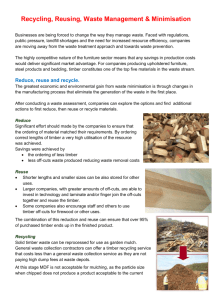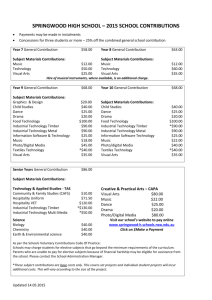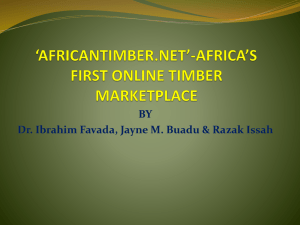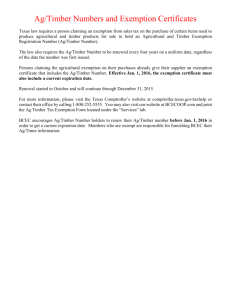Market Analysis Timber Sept 2014 Document DOC
advertisement
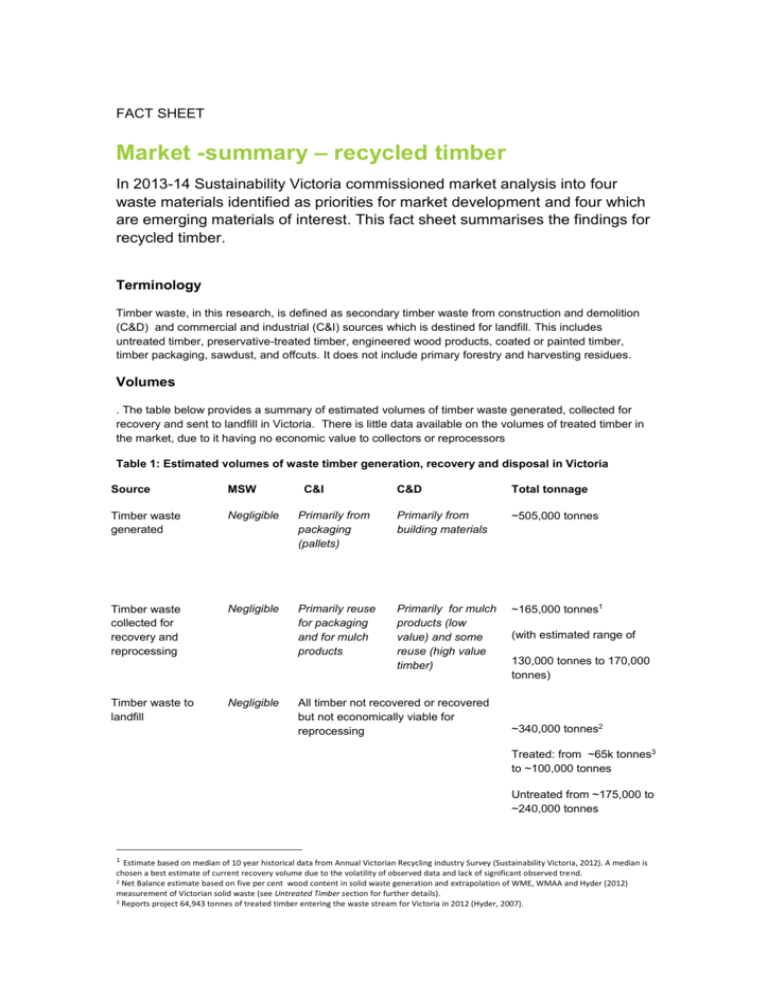
FACT SHEET Market -summary – recycled timber In 2013-14 Sustainability Victoria commissioned market analysis into four waste materials identified as priorities for market development and four which are emerging materials of interest. This fact sheet summarises the findings for recycled timber. Terminology Timber waste, in this research, is defined as secondary timber waste from construction and demolition (C&D) and commercial and industrial (C&I) sources which is destined for landfill. This includes untreated timber, preservative-treated timber, engineered wood products, coated or painted timber, timber packaging, sawdust, and offcuts. It does not include primary forestry and harvesting residues. Volumes . The table below provides a summary of estimated volumes of timber waste generated, collected for recovery and sent to landfill in Victoria. There is little data available on the volumes of treated timber in the market, due to it having no economic value to collectors or reprocessors Table 1: Estimated volumes of waste timber generation, recovery and disposal in Victoria Source MSW Timber waste generated Negligible Timber waste collected for recovery and reprocessing Negligible Timber waste to landfill Negligible C&I C&D Total tonnage Primarily from packaging (pallets) Primarily from building materials ~505,000 tonnes Primarily reuse for packaging and for mulch products Primarily for mulch products (low value) and some reuse (high value timber) ~165,000 tonnes1 All timber not recovered or recovered but not economically viable for reprocessing (with estimated range of 130,000 tonnes to 170,000 tonnes) ~340,000 tonnes2 Treated: from ~65k tonnes3 to ~100,000 tonnes Untreated from ~175,000 to ~240,000 tonnes 1 Estimate based on median of 10 year historical data from Annual Victorian Recycling industry Survey (Sustainability Victoria, 2012). A median is chosen a best estimate of current recovery volume due to the volatility of observed data and lack of significant observed trend. 2 Net Balance estimate based on five per cent wood content in solid waste generation and extrapolation of WME, WMAA and Hyder (2012) measurement of Victorian solid waste (see Untreated Timber section for further details). 3 Reports project 64,943 tonnes of treated timber entering the waste stream for Victoria in 2012 (Hyder, 2007). Preservative-treated timber Due to its toxic nature, all waste timber in Victoria that has been treated with preservatives such as Copper Chrome Arsenate (CCA), is sent to landfill. Given its lack of economic value, waste management companies have no incentive to track volumes. Preservative-treated timber is currently found either in mixed waste collection or as contamination in non-treated timber waste streams. There appear to be considerable barriers to preservative treated timber recycling. For example, only a third of the timber in power poles which have been treated, can be recovered. One suggestion for reuse is for fuel, but this is problematic due to the difficulty of meeting air emissions standards. Products Mulch, compost and animal bedding are made from recovered pallets, plywood, and some painted wood and insecticide-treated timber. Engineered wood such as particleboard, can include chipped recycled timber content. In Australia, at least one particleboard manufacturer uses quantities of pre-consumer particleboard and C&I timber waste in their product.. Pellets, briquettes and dried wood chip are produced as a fuel for energy generation. All untreated types of timber waste have potential for energy from waste applications. Bio Char can be produced from waste timber and is valued for its role in increasing the carbon content of soil. The market for biochar in Victorian is in its infancy, with no retailers currently operating. Market overview Indicative estimates of the financial value of recycled timber materials at various transactional points in the market are presented below. Table 2: Summary of estimated value and volumes of the Recycling market component Estimated value ($ million) Volume Collection for recovery ~ $6.6 m 165,000 tonnes Based on payment for collection in the region of $40 per tonne Indicative estimate of current market size $5.0 m to $8.3 m 105,000 tonnes reprocessed (i.e. economic and non-contaminated) Reprocessing Based on payment for reprocessing in the region of $30 to $50 per tonne End product $1.05 m to $6.3 m Based on low value timber only, valued between $10 to $60 per tonne Collection for recovery 60,000 tonnes to reprocessor but uneconomic (stockpiled) 105,000 tonnes In general, the average cost of collection, transport and resource recovery of C&D and C&I materials is in the region of $70 per tonne, with about $40 attributed to collection alone 4. Reprocessors Industry consultation suggests that the price paid to reprocessors is generally in the region of $30 to $50 per tonne. End product The market value of recycled timber is segmented according to a wide range of values placed on different end products. These include the following. High value re-use products such as salvaged hardwood flooring used in landscaping and architecture. Low value re-use products such as pallets and packaging. Low value reprocessed products such as mulch or animal bedding. (Stakeholder consultation found a wide range of prices paid for mulch, varying from around $0 per tonne to as much as $60 per tonne. In some recycling facilities mulch does not command a selling price and is given away, with profits being made on the rebate made from diverting the timber from landfill.) Uneconomic products, where the value of the product is less than the cost of reprocessing5. This leads either to stockpiling, sale at zero price, or the need to send waste to landfill. This product is suitable for waste to energy applications. Drivers for recycling low value timber Due to the low economic value of most waste timber, the main drivers for its recovery, reprocessing and use are landfill levy credits and the desire by both waste management companies and their customers to manage timber waste in a more environmentally responsible way. Stakeholder consultation revealed a desire among waste processors to provide innovative solutions to waste timber recycling, including for manufactured boards, where opportunities are believed to exist. Market trends and growth Analysis of historical recovered timber in Victoria showed no discernible trend, suggesting a stable rate of around 165,000 tonnes diversion is expected, with about 45 per cent of this timber suitable for re-use and reprocessing. This could potentially increase as a result of factors such as population growth, building demolition and new construction, product stewardship requirements, increasing acceptance of recycled products and creation of waste to energy opportunities. As with other materials, recycled timber products compete predominantly with virgin material, and face high competition and price sensitivity. Stakeholders note that demand for these products is expected to be stable over time due to the relatively simple and established production processes. Prices for mulch in particular are highly competitive and these pressures are expected to continue. Accordingly, future growth will be highly dependent on increasing the attractiveness and financial conditions for recycling timber. Supply and demand This section summarises the supply and demand conditions of the potential timber recycling markets, together with considerations of both the economic and waste recovery hierarchies. 4 5 WME, WMAA and Hyder, 2012 The Mapping the Timber Waste Stream from Building Demolition 2007 (Forsythe Consultants) study found a lack of end products and markets for low value demolition timber, such as small dimension Douglas Fir, hardwoods and all pine, particleboard and MDF products, limits recovery and reprocessing of these products. Potential supply An estimated 400,000 tonnes per annum, or 80 per cent, of timber waste in Victoria is currently not recovered. This potential supply of timber for recycling is shown below. Table 3: Estimated potential supply of timber waste for recycling Potential supply Tonnes per annum Description Untreated timber recovered but not recycled 60,000 Suitable for low value products only; does not currently have an economically viable market Untreated timber in landfill 227,000 Suitable for low value products only; not currently economically viable to recover Preservative-treated timber in landfill 113,000 No current recycling markets Potential demand There are three key opportunities for timber recycling that could absorb 137,000 tonnes per annum or 33 per cent of timber currently sent to landfill. Table 4: Estimated potential demand opportunities for timber waste Potential demand opportunity Tonnes per annum Waste Hierarchy Engineered wood 110,000 High: material is recycled Waste to energy 22,000 Low: material is “down-cycled” Railway sleepers for landscaping 5,000 High: material is re-used Considerations of economic viability and waste hierarchy The use of wood for engineered wood and waste to energy purposes will compete. The most economic source of potential supply will be from timber already recovered but not processed. The relative scarcity (i.e. 65,000 tonnes per annum vs total demand of 137,000 tonnes) intensifies competition and may create the need to prioritise actions or efforts to improve each market. Efforts to prioritise opportunities include consideration of: differing positions of engineered wood (high) and waste to energy (low) on the waste hierarchy the total economic value of producing energy (from waste to energy) vs. reprocessing or re-use of timber in the recycling chain. Market risks Engagement with large timber reprocessors indicates that the industry perceives the greatest market driver in Victoria to be a desire by customers to ensure their waste is recycled. The growth of automated demolition processes that are more economic for operators to run but result in more homogenous C&D waste to landfill will also contribute to less clean streams of timber waste. A study by Forsythe Consultants Mapping the Timber Waste Stream from Building Demolition, 2007 asked timber recyclers and salvage yard operators about key impediments to their ability to reprocess and sell recovered materials. One prominent theme was the lack of guarantee of timber supply which prevented confidence in investment and the scale of operations. Market barriers The key barriers to increasing the recovery of timber for recycling markets include: securing a cost effective recycled waste stream due to competing demand for other uses of low grade timber (i.e. markets for mulch and potentially waste to energy). price competitiveness and availability of substitute virgin timber. costs of labour and capital required for suitable source separation. Market opportunities Key opportunities to increase recovery and re-use identified by market participants centre around finding markets for untreated timber currently considered uneconomic for reprocessing, namely in: waste to energy: improving the conditions for turning uneconomic timber waste to energy. The business case for energy from waste applications also extends to the potential use of preservative treated timber as a feedstock for energy. engineered wood: increasing the use of timber in recycled engineered wood products such as particleboard. railway sleepers for landscaping: increasing markets for recovered (used) railway sleepers. This fact sheet summarises a more comprehensive market analysis report completed by NetBalance on behalf of Sustainability Victoria (August 2013). Due to the confidential nature of some information provided by industry stakeholders, the full market analysis report is not publicly available. Further Information For more information contact Jane Street on: T: (03) 8656 6709 E: jane.street@sustainability.vic.gov.au or visit www.sustainability.vic.gov.au/marketanalysis Sustainability Victoria Level 28, Urban Workshop, 50 Lonsdale Street, Melbourne VIC 3000 Phone (03) 8626 8700 sustainability.vic.gov.au Published by Sustainability Victoria. Market summary – recycled timber © Sustainability Victoria, September 2014 IWM030



